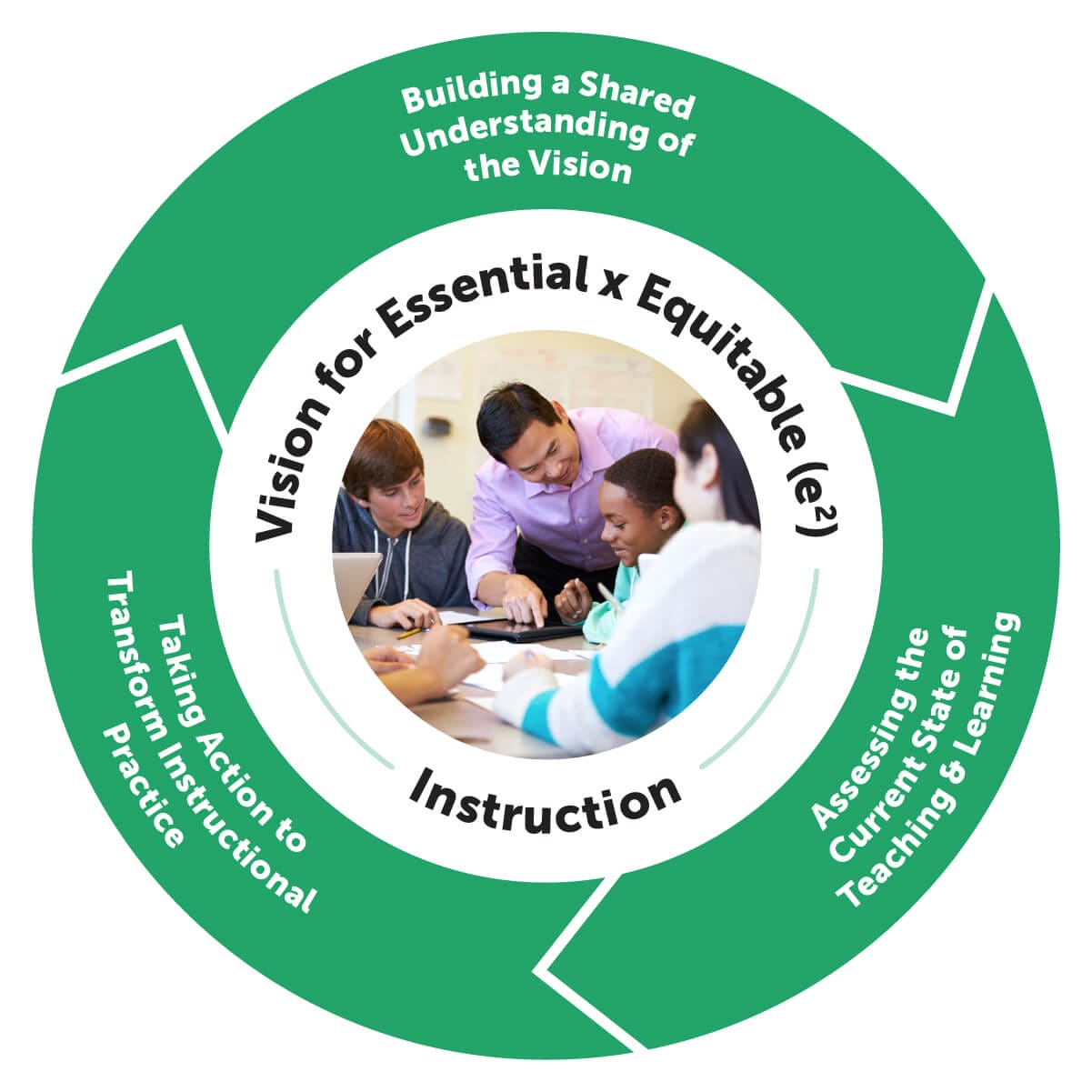The Challenge
Research makes clear that high-quality instructional materials (HQIM) play a critical role in kickstarting important shifts in how students are taught and what they learn — and many districts are deciding to make the investment in better materials. EdReports is a great starting place to find standards-aligned materials. And, when educators lead this transition, they want to make sure they get it right for students and school staff.
They want to know:
- How do you sort through the long list of strong curricula to find the one that is right for your district?
- Which one will best serve my unique student population?
- Which curricula do a good job of supporting multilingual learners?
- Which curricula are culturally responsive and sustaining for learners from diverse backgrounds?
- Which resources and supports can help my teachers through this transition?
- How can I make sure we’re not just swapping textbooks, but transforming instruction?
A Student-Centered Approach
These are the kinds of questions that a team from South San Francisco Unified School District (SSFUSD), a pre-K through 12th-grade school district in California serving a diverse student population of approximately 8,000, were asking in fall of 2022. They were seeking to adopt math curricula to use across their schools that would help them address two common issues:
- Learning recovery challenges following the pandemic
- Persistent equity gaps
Their desire to find their ideal curricula through a student-centered process led them to our team at Student Achievement Partners (SAP). We specialize in providing educators with the concrete guidance and tools they need to deliver the kind of joyful, asset-based, high-quality instruction that prepares all students, especially Black and multilingual students, to thrive academically and lead choice-filled lives. Our approach is grounded in the latest pedagogical research and balances both the essential (grade-level, standards-aligned) and equitable (responsive to the individual student).
Understanding Needs & Strengths

In order to help SSFUSD adopt and select a new mathematics curriculum, we led their team through a landscape analysis. We used this process to build a shared vision for essential and equitable (e²) instruction and understand and assess the current state of teaching and learning in their schools relative to that vision.
Our team traveled to South San Francisco to help them highlight areas of success, understand challenges, and make decisions, informed by a human-centered data collection process that centered the needs and assets of the district’s diverse student body.
“I appreciated…looking at data in a human-centered way. [I]n math especially we focus so much on numerical data of how many kids got this question right or what percentage of kids didn’t pass the test and all of that is important, but it just widened the picture so much that we were actually looking at the student experience in the classroom and that data proved to be really important.”
SAP’s Customized Tools & Collaborative Approach
Our partnership with SSFUSD focused on building capacity for the team and ensuring the result was truly driven by and for educators. To do this, we worked closely with them to customize and implement two SAP tools designed to help them understand the unique needs of their students and staff and select the kind of curricula that would make it possible to transform teaching and learning in their district: Learnings Walks and Survey and Interview Protocols.
- The e² Learning Walk Tool™: We worked with SSFUSD to customize a Learning Walk Tool™ that supported them in gathering non-evaluative data through a series of brief classroom visits. With this data, they were able to create a snapshot of the teaching and learning across classrooms and schools. The Learning Walk Tool intentionally focuses on students’ experiences in the classroom through the interactions between students, teachers, and content. SSFUSD and our team conducted the first learning walks together, which allowed us to provide guidance on how best to use the tool and analyze data, and gave district staff the opportunity to provide our team with context for the trends they were seeing, as well as to learn how to use the tool on their own.
- The e² Survey and Interview Protocols™: While in South San Francisco, our team also shared a set of resources known as Survey and Interview Protocols, which are designed to capture the authentic perspectives of teachers and students that reflect the realities of classrooms. Too often, data collection processes focus solely on grade-level outcomes while neglecting the aspects of lived experiences that contribute to equitable instruction, which can’t be as easily quantified. These protocols facilitate the inclusion of additional input into the data collection process in a way that elevates the voices, leverages the assets, and honors the brilliance of students and teachers.
“The walkthrough tool…really gave
me a clear picture of what a math
classroom should look and feel like.”
“What I appreciated most about participating was feeling like I had a process to really get data from all the stakeholders in our district…being able to really see what the needs are and elevate the different voices was just the biggest thing I appreciated in this process.”
Karie Mullassery, Secondary Math Teacher on Special Assignment at SSFUSD
Results & Impact
By the end of the landscape analysis process, SSFUSD had completed:
- 104 learning walks across 9 sites
- 912 surveys of students and teachers
- 18 interviews of administrators, teachers, and parents
- 11 student focus groups
- 6 teacher focus groups
We then convened with SSFUSD to analyze the data gathered and create a rubric that then guided the selection of math curricula at the elementary, middle and secondary levels.
In the fall of 2023, teachers in SSFUSD began piloting two new math curricula that met their criteria and will finalize their decision in 2024.
“The [new] curriculum [we’re now piloting] allows students to deeply understand the conceptual side, the “why” of math through hands-on learning opportunities and real-life problems that challenges them to make discoveries about math. I act as a guide to their learning rather than the ‘all knowing teacher’ which provides more time to work out misconceptions with students while the rest of the class engages with the standards. I saw students being able to apply knowledge in ways I have not before because they were not just repeating a pattern or formula, but they were understanding how to actually solve a problem.”
Sophia Buscher, Sixth-Grade Math Teacher
The landscape analysis process not only helped them identify which curricula to pilot, but also next steps with regard to implementation.
“This is really going to guide us in what each stakeholder group needs. What are your students going to need? What are our teachers going to need? What are administrators going to need?
Karie Mullassery, Secondary Math Teacher on
What are our families going to need?”
Special Assignment at SSFUSD
Educators in SSFUSD have had such a positive experience selecting their math curricula, that they’re looking to repeat the process for literacy.

Insights Gained Along the Way
- Don’t rush it! This process takes time — plan for about 3-6 months.
- Allocate staff who can give this work the focus it merits.
- Involve a real variety of folks early on — students, families, educators, and leadership.
- Working on literacy first? Include your math leader. Math first? Include your literacy leader. Our tools and processes can be adapted for future curricula selection.



